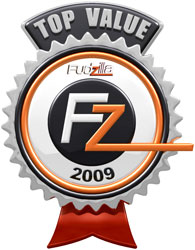Index


Review: Cheap as chips
This review is also available in German.
After walking in Lynnfield land, AMD struck back with the heavily delayed AMD Propus dice. This is AMD's first quad-core CPU retailing with a price below $100 or €80 on launch date. Meanwhile this is not the only quad-core at such a low price-level, the old Phenom 9650 is available at the same price with a tad lower clock but with 2MB L3 cache.
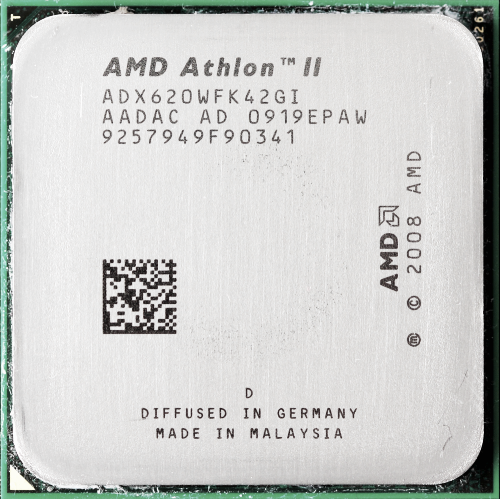
We got the AMD Athlon II 620 which is the only interesting of the Propus offerings. AMD also introduced the Athlon II 630 but the 200MHz speed bump costs you at least a 22% price-premium. The 620 is clocked with 2.60GHz and offers the same features as any Phenom II except the L3 cache. You get 512kB 2nd level cache and 64kB L1 caches for instructions and data per core. For a better comparison we have also included the old Phenom 9600/9650 in our benches to see which offering is the better one for you.
Testbed:
Motherboard:
MSI P55-GD80 (provided by MSI)
Intel P55
MSI 790GX-GD70 (provided by MSI)
AMD 790GX/SB750
MSI DKA790GX (provided by MSI)
AMD 790GX/SB750
Gigabyte GA-EP45-UD3P (provided by Gigabyte)
Intel P45/iCH10R
Intel DX58SO "Smackover" (provided by Intel)
Intel X58/iCH10R
CPU:
Intel Core i5 750 (provided by Intel)
Intel Core i5 870 (provided by Intel)
AMD Athlon II X4 620 (provided by AMD)
AMD Phenom 9650 (provided by AMD)
AMD Phenom II 810 (provided by AMD)
AMD Phenom II 905e (provided by AMD)
AMD Phenom II 955 Black Edition (provided by AMD)
AMD Phenom II 965 Black Edition (provided by AMD)
Intel Q9450 (provided by Intel)
Intel Q(X)9650 (provided by Intel)
Intel Core i7 920 (provided by Intel)
Intel Core i7 975XE (provided by Intel)
CPU-Cooler:
Scythe Kabuto (provided by Scythe-Europe) for AMD and Intel E/Q
Thermalright Ultra 120 eXtreme 1366 (provided by Thermalright) for Intel 1366
Thermalright MUX-120 1156 (provided by Thermalright) for Intel 1156
Memory:
Kingston 2GB Kit PC2-9600U KHX1200D2K2/2G (provided by Kingston)
1066MHz CL5-5-5-15 CR2T at 1.90V for AMD DDR2
Qimonda 3GB Kit PC3-8500U (provided by Qimonda)
1066MHz CL7-7-7-20 CR1T at 1.55V for Intel i7
Kingston 3GB Kit PC3-10600U KHX1600D3K3/2GX (provided by Kingston)
1333MHz CL7-7-7-20 CR1T at 1.50V for AMD DDR3 and Intel P55
1440MHz CL7-7-7-20 CR1T at 1.50V for Intel P55
1600MHz CL8-8-8-23 CR1T at 1.60V for AMD DDR3 FSB overclocking
1644MHz CL9-8-8-23 CR1T at 1.60V for Intel P55
1800MHz CL9-8-8-23 CR1T at 1.65V for Intel P55
Graphics Card:
MSI R4850-2D1G-OC (provided by MSI)
Power supply:
PC Power & Cooling Silencer 500W (provided by PC Power & Cooling)
Hard disk:
Samsung F1 1000GB (provided by Ditech)
Case fans:
SilenX iXtrema Pro 14dB(A) (provided by PC-Cooling.at)
Scythe DFS122512LS
Case:
Cooler Master Stacker 831 Lite (provided by Cooler Master)
OS:
Since we are still not fans of Vista, all tests are performed with XP SP3. As 64-bit software is still not very common, we stick with the 32-bit version.
We were a bit surprised to see that AMD stuck with the 95W TDP rating. The much smaller dice should be able to deliver decent performance with much lower energy consumption. AMD decided to set the VCore to an ridiculously high 1.4000V which is the same as the Phenom II 965 Black Edition. Also, for some reason the idle power of this CPU only reduced to 1.1200V. That is very disappointing.
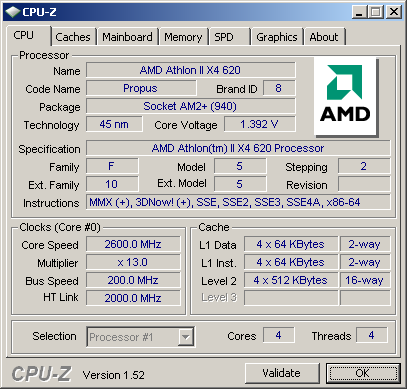

Overclocking:
Due to the high VCore we believed this CPU would go past 3GHz without the need of any VCore increase. As you can see, getting to 3.40GHz with our MSI 790FX-GD70 board was a piece of cake.
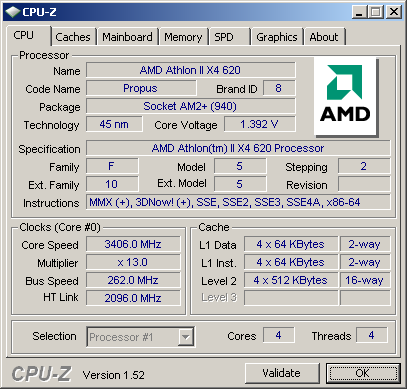
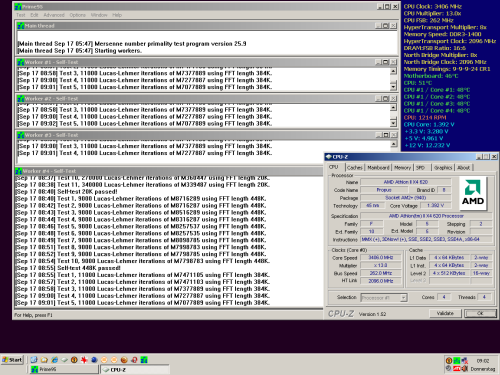
Increasing the VCore to 1.5500V we could manage a stable 3.70GHz. Don't be shocked about the high VCore, because there is no L3 cache the temperatures are always in safe limits and always below 60°C while the CPU is specified with 71°C. There are also no worries about Cool'n'Quiet as it will work flawlessly, because this voltage will also be increased if you go over the specified VCore.
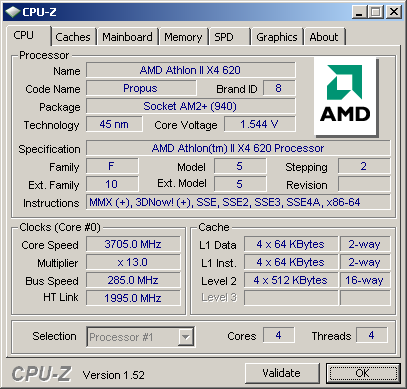
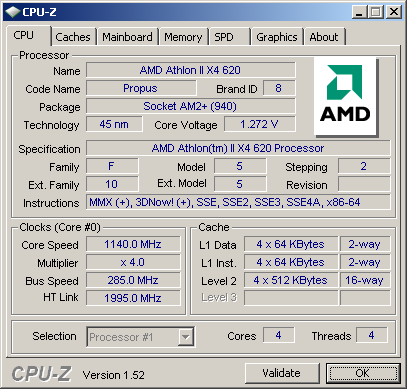
Under-Voltaging:
As always we will try to reduce the voltage, which will make sense especially with such an high VCore. We encourage you to do the same, if your board does support it, because it will shave off some bucks of your power-bill, will keep your system cooler and there is no other disadvantage. The Cool'n'Quiet voltage will not change, but you see we can manage the stock 2.60GHz with just the idle-power.
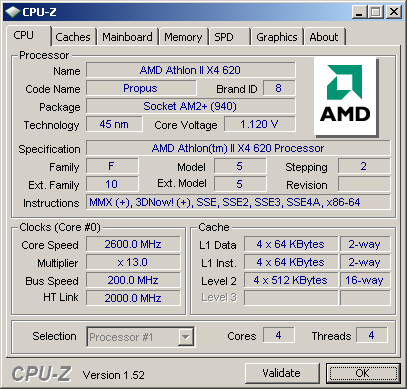
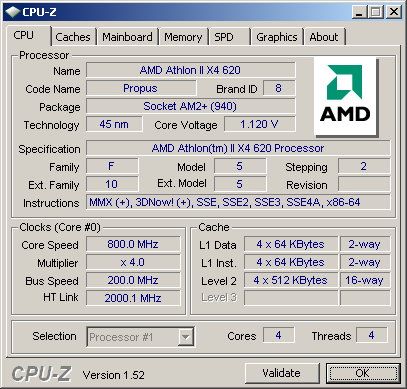
The more interesting part now is if we can overclock while under-voltaging and find a good balance between power-consumption and clock speed. The best we could find was 3.0GHz at 1.2500VCore which is still considerably below the default VCore but with a much more appealing clock speed.
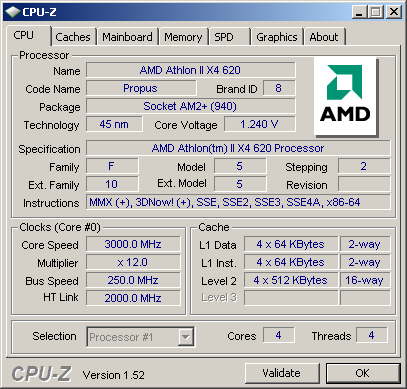
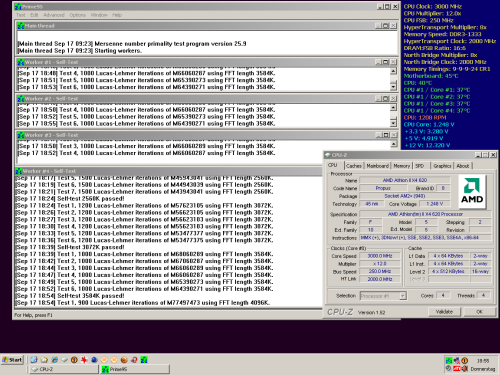
Our benchmarks are quite self-explanatory. Beside the usual benchmarks we included the Far Cry 2 Bench, which should show only the benefit of a faster CPU. Intel i5/i7 CPUs are benched without HT and without Turbo to get a clock by clock comparison. Now we will see if AMD is correct with its assessment that the missing L3 cache won't have a noticeable impact. Please note we did not rebench all other CPUs because that would have cost too much time, but we think the impact of the new BIOS is negligible. The Phenom II 905e is clocked only 100MHz slower, but the L3 cache does not help much in Cinebench where both CPUs come out neck and neck. Only the x264 tests shows minimal advantages.
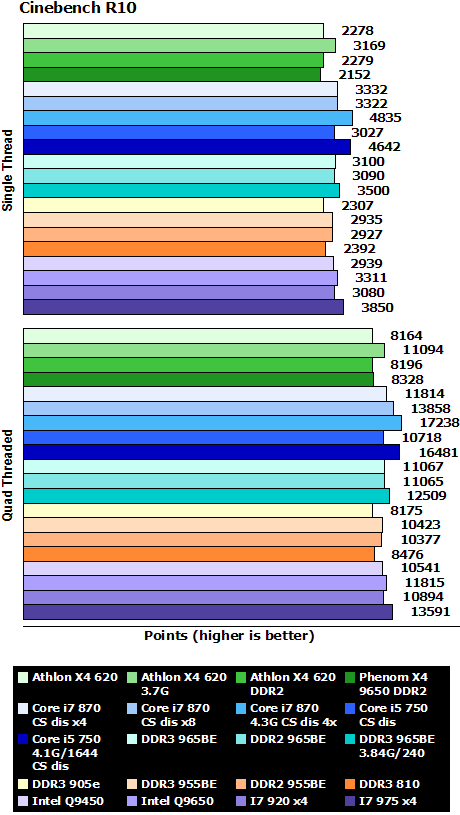
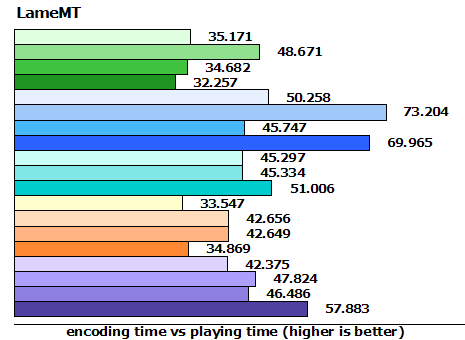

3DMark 2003 run at 1600x1200, 3DMark 2006 used defaults. As you can see, more CPU muscle doesn't really help. FarCry2 benching is a mess, the results vary quite a lot, the more often you do it the slower it gets. But anyway, the results are still quite close. The L3 cache surely helps with games, but you may compensate that disadvantage with higher clock speeds.

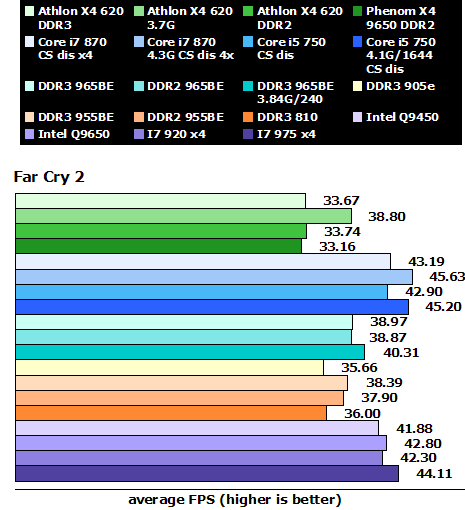
As you could expect, the high VCore does have a substantial impact on power consumption. Lowering the VCore does help, but AMD is still way behind Intel considering efficiency. The 905e with only 100MHz slower clock but with the full 6MB L3 cache beats the Athlon II X4 by a big margin, only decreasing the VCore could turn the results around.
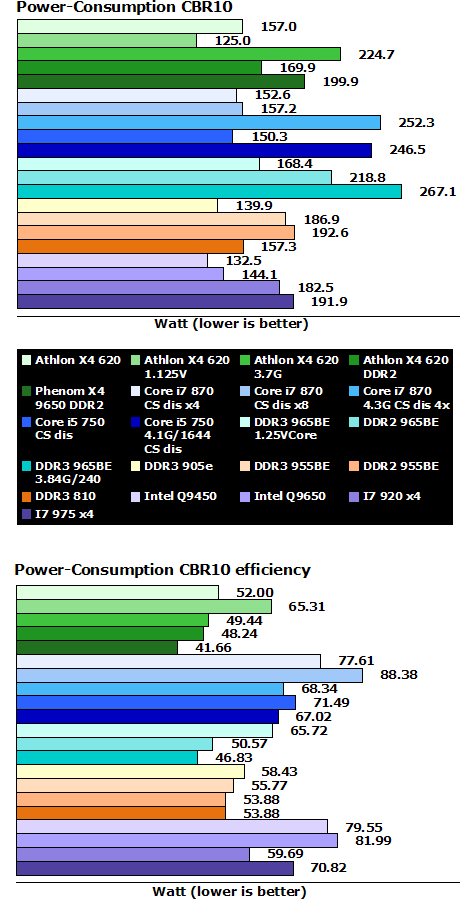
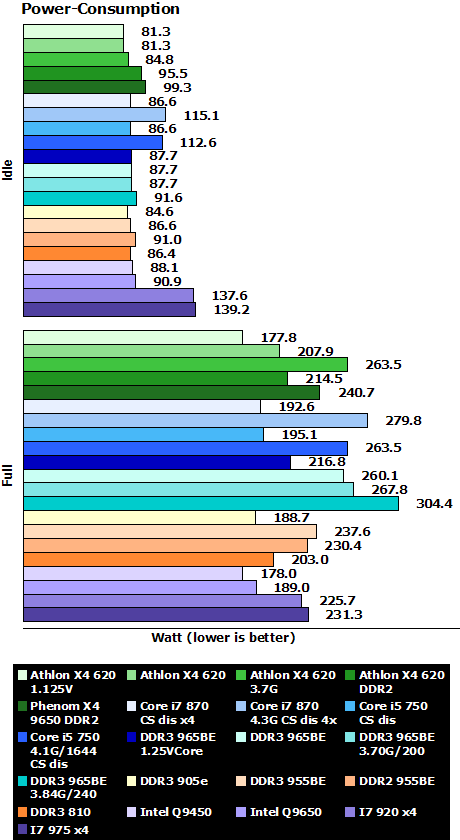
Before we can do a conclusion, let's see the overall scores. Without L3 cache the Athlon II X4 does not do bad at all. For half the price of the i5 750 (without Turbo) you get nearly 86% of it's performance, that's not bad at all. Also the Athlon II/Phenom II is clock by clock faster compared to the older brothers, so the AMD Phenom 9650 with only 2.30GHz clock but with 2MB L3 cache does not stand a chance. Considering the extremely high power-consumption of this CPU it's clearly the inferior offer.
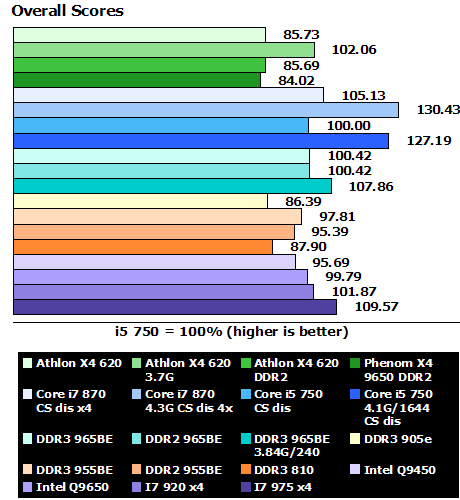
To give you a better overview we compare system costs. We calculated the cost of the used mainboards, CPUs and graphics-card and also the lowest possible price for a 4GB kit for dual-channel or a 3GB kit for triple-channel. Memory of course PC3-12800 (1600MHz) with CL8-8-8-24 and PC2-8500 CL5-5-5-18. Last week we saw an increase of prices in the DDR2 market, which does hurt AMD a bit. So the overclocking memory settings may not apply but it gives you a good overview. The Q9450 is not longer readily available, and if you find it, you'll find it at horribly high prices, so we used Q9550 pricing. Because the Gigabyte EP45-UD3P is not offered any more we choose the MSI P45 Platinum price.
The market has shifted a bit since the introduction of the Lynnfield CPUs. The AMD offerings have fallen between €10 to €20, for instance the 965BE is now at about €180. Also the boards saw some price cuts. Even the Intel Q9 series got some minor price-cuts. All in all the AMD Athlon II 620 DDR2 platform has the best price/performance ratio of any system which could be matched with some 785G DDR3 boards.
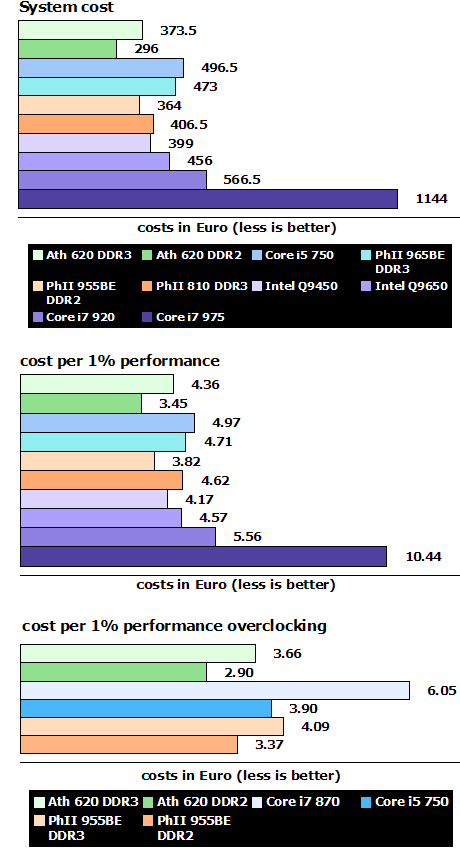
Conclusion:
The AMD Propus core is not bad at all. While removing the L3 cache hurts performance in games, the overall scores show it can come close to the i5 750 (without Turbo) at half the cost. The only disadvantage AMD still faces is the incredibly high power-consumption and the ridiculous high default voltage settings.
The AMD Athlon II X4 620 is priced €79,38 which is as cheap as any Phenom II X3 offering. Now AMD is in a tough situation because we think the triple-core offerings make no sense at all. Even huge L3 cache can't compensate for one core less. Its sibling, the AMD Athlon II X4 630, is priced about €96 in UK and still above €100 in Euroland which is heavily over-priced.
However, if power consumption and thermals are your biggest concern, AMD should soon launch the Athlon II X4 605e at 2.3GHz and with a 45W TDP.
Regardless of the high energy consumption we feel that the 620 deserves our Top Value Award. We have shown how to lower the VCore and get the same or better performance so this CPU becomes even more attractive.
